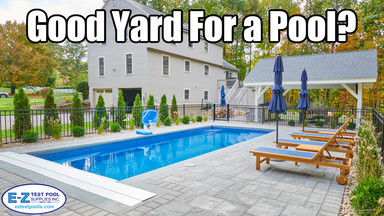Published by E-Z Test Pool Supplies on 02/18/2019
3 Determining Factors If You Have A Good Yard for a Swimming Pool
Here is a question that you may not find many pool retail companies quick to want to bring up. And that is, “Can you even put and in-ground pool into your yard?” Now the reason they won’t mention this question might not be for the reason you’d expect.

In general, pool companies are not owned by unethical people who want to just sell, sell, sell you a product whether or not you need it. Most people in business have a passion for their particular products and services and can demonstrate why you too can benefit from these things. They provide the consumer with products and services that improve their quality of lives, and you the consumer help them earn an honest living. It’s a win-win.
That being said, this topic is still not one that is readily brought up. Maybe some places believe if they even bring up this idea they’ll scare you right out of putting in a pool before you are started!
This couldn’t be further from the truth. You want, when you do buy a pool, to be thoroughly convinced that it is right for you…and your yard. It’s not a question to skirt around, because honestly not all yards can fit an in-ground pool. In fact, if your yard cannot properly accept a pool, you don’t want to force installation of a pool because you will not end up happy with your purchase!
Let’s take time to discuss the 3 main determining factors that will determine whether or not you have a good yard for a swimming pool.
- ACCESSIBILITY
- YARD LAYOUT
- WHAT LIES UNDERGROUND
ACCESSIBILITY
In order to install a pool there needs to be reasonable access into your yard with a large amount of materials and equipment.

Some limiting features (granted this is not an exhaustive list) include:
- Can equipment and trucks be driven right in?
- Are there stone walls, or fences that will limit access? – in many cases fencing can be temporarily removed in sections.
- Are there low hanging power or utility lines that will increase difficulty?
- Is there a paved driveway that will help gain some access to the property – in general this is good, but even then it may require laying plywood sheets down to avoid damage from equipment.
- Will you need access through a neighbor’s property to reach the site? Is your neighbor amenable to allowing access?
YARD LAYOUT
Once in to the site what are the particular limitations of the site where the pool will go?
Just a few questions here…
- Is the pool site location flat or sloped?
- Is there lots of space to work around the pool? Wide open or small?
- Are there setbacks determined by local government that limit size and location?
- What is the location of the septic system and leach field?
- Are there trees that will need to come down?
- Will tree stumps need to be removed?
- Are there any large visible boulders that will need to be moved (if possible)?
- Is there an installed sprinkler system that may be in the way? If so, then can it be moved or does it need to be worked around?
- Is there an area of water run-off during hard rain that will erode or potentially damage your pool?
WHAT LIES UNDERGROUND?
This is a huge consideration not thought of until after digging has begun. Because of this concern many pool installers will dig test holes in and around the area to get an idea what they may be in for.

|

|

|
Some potential problems or concerns include the following:
- Hitting large boulders underground. Some can be moved or broken up. Some cannot.
- High water table or areas that are habitually damp (springtime etc.). In some cases French drains may be installed to correct this problem.
- Large amounts of poor quality fill (whether it be construction fill such as wood, tree stumps, cement blocks, etc. that was buried when the builder built the home and graded the property)
- Rock ledge.
This is a game changer. When hitting
ledge the homeowner has 2 choices –
1) Costly blasting that may not be so successful.
OR
2) Bringing the top of the pool up above the surface of the ground – this is done by installing a Radiant pool which can be installed throughout any grade or depth.

|

|
As we said above this is not a totally exhaustive list, but it does give you a pretty good idea of some main factors that will limit installation of an in-ground pool, possibly increase the cost, or even prevent completion of the project .
It is important to note is that any pool installer that will tell you that you can put an in-ground pool in any yard is either inexperienced or stretching the truth. Neither are desirable traits in a pool installer!
The long and short of this is to take your time and do your homework.
True professionals in the business are not put off by your questions and will not avoid answering you, or checking into things to get you the correct answers.
Ask questions – lots of them!
In the end you’ll be glad you did!





